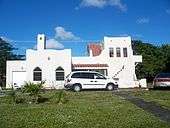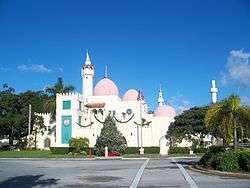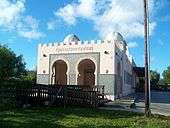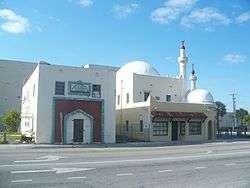Opa-locka Thematic Resource Area
|
Opa-locka Thematic Resource Area | |
 | |
| Location | Opa-locka, Miami-Dade County, Florida |
|---|---|
| MPS | [1] |
| NRHP reference # | 64000117 |
| Added to NRHP | March 22, 1982 |

The Opa-locka Thematic Resource Area is a group of thematically-related historic sites in Opa-locka, Miami-Dade County, Florida, United States. The area comprises 20 surviving Moorish Revival buildings which are listed on the National Register of Historic Places. The buildings were designed in the mid-1920s by architect Bernhardt E. Muller as part of the development of Opa-locka by Glenn Hammond Curtiss, an aviation pioneer, and his development and sales company, Opa-locka Company. In developing Opa-locka, Curtiss sought to follow a theme inspired by the Arabian Nights. The designated buildings include the Opa-locka Company administration building, considered the anchor of the Opa-locka development, the Opa-locka railroad station, and the development's first commercial building, the Harry Hurt Building.
History of the sites
After Glenn Curtiss, an aviation pioneer, retired from aircraft development and manufacturing in the 1920s, he became a real estate developer in Florida. In 1926, during the Florida land boom of the 1920s, Curtiss founded the Opa-locka project on 4.2 acres of land in northwestern Miami-Dade County, Florida. The Opa-locka Company was the development and sales company established by Curtiss for his Opa-locka project.[2]
Curtiss named the development "Opa-tisha-wocka-locka", which meant "a big island covered with many trees and swamps."[3][1] He shortened it to Opa-locka. Curtiss hired the American architect Bernhardt E. Muller to design the town in the themes of an "Arabian Fantasy" or "Arabian Nights."[4] Some sources indicate that Curtiss was inspired by his viewing of the 1924 motion picture The Thief of Baghdad.[4]
Muller designed 86 buildings in Opa-locka in a Moorish Revival style.[1] The buildings elements include onion-shaped domes, minarets, crenelated parapets, Saracenic arches, watchtowers, mosaic tile, and outdoor spiral staircases. The streets were given Arabian-related names, such as Ali Baba Avenue, Sharazad Avenue, Caliph Street, Sinbad Avenue, Sesame Street, and Aladdin Street.[3][1]
The Administration Building has been described as "the anchor of the new city,"[1] and was designed by Muller as the headquarters for the Opa-locka Company. It was later used as Opa-locka's City Hall. The building has been called "The Nation's Weirdest City Hall",[4] and was reported to have been inspired by the description of the palace of the Emperor Kosroushah in One Thousand and One Nights. The Administration Building includes "a dazzling array of domes, minarets, and arches, which combined to create a delightful oriental palace and afforded the appearance of a magical, fantasy city."[1]
The 1926 Miami hurricane struck in September of that year and destroyed many of the original Moorish-style buildings, but some survived.[3][5] Based on a survey and documentation prepared later in the twentieth century, twenty of the surviving structures have been listed on the National Register of Historic Places.[3] The Opa-locka Company administration building is one of the listed buildings.[6] Three other commercial buildings were listed on the National Register together.[1]
List of registered sites
The following buildings were added to the National Register of Historic Places as part of a Multiple Property Submission with the 1981 study, or later, consistently with the study guidelines of the Opa-locka Thematic Resource Area report.
| Resource Name | Also known as | Location | Added |
| Harry Hurt Building | Logan Executive Center | 490 Ali-Baba Avenue 25°54′05″N 80°15′04″W / 25.901389°N 80.251111°W | March 22, 1982 |
| Opa-locka Company administration building | Opa-locka City Hall | 777 Sharazad Boulevard 25°54′17″N 80°15′11″W / 25.904722°N 80.253056°W | March 22, 1982 |
| Opa-locka Bank | First Baptist Church | 940 Caliph Street 25°54′21″N 80°15′01″W / 25.905833°N 80.250278°W | May 19, 1983 |
| Opa-locka railroad station | 490 Ali Baba Avenue 25°54′01″N 80°15′12″W / 25.900278°N 80.253333°W | June 25, 1987 | |
| H. W. Baird House | Edmunds House | 401 Dunad Avenue 25°54′11″N 80°15′22″W / 25.903056°N 80.256111°W | August 17, 1987 |
| George Cravero House | Lewis House | 1011 Sharar Avenue 25°54′28″N 80°15′05″W / 25.907778°N 80.251389°W | August 17, 1987 |
| J. W. Crouse House | Rey House | 1156 Peri Street 25°54′33″N 80°14′56″W / 25.909167°N 80.248889°W | August 17, 1987 |
| Clarence Etheredge House | Raad House | 915 Sharar Avenue 25°54′27″N 80°15′09″W / 25.9075°N 80.2525°W | August 17, 1987 |
| R. M. Griffiths House | Ortiz-Figueroa House | 826 Superior Street 25°53′53″N 80°15′04″W / 25.898056°N 80.251111°W | August 17, 1987 |
| S. K. Haislip House | Payon-Diaz House | 1141 Jann Avenue 25°54′31″N 80°14′57″W / 25.908611°N 80.249167°W | August 17, 1987 |
| Helm Stores and Apartments | 1217 Sharazad Boulevard 25°54′18″N 80°14′53″W / 25.905°N 80.248056°W | August 17, 1987 | |
| Roy Helms House | Rose House | 721 Sharar Avenue 25°54′24″N 80°15′17″W / 25.906667°N 80.254722°W | August 17, 1987 |
| A. H. Higgins Duplex | Smith House | 1210-1212 Sesame Street 25°54′20″N 80°14′53″W / 25.905556°N 80.248056°W | August 17, 1987 |
| King Trunk Factory and Showroom | O'Dell Apartment House | 951 Superior Street 25°53′55″N 80°14′54″W / 25.898611°N 80.248333°W | August 17, 1987 |
| C. E. Long House | Peterman House | 613 Sharar Avenue 25°54′21″N 80°15′20″W / 25.905833°N 80.255556°W | August 17, 1987 |
| E. E. Root Building | Rondon Building | 111 Perviz Avenue 25°54′15″N 80°15′14″W / 25.904167°N 80.253889°W | August 17, 1987 |
| L. M. Taber Duplex | Brown House | 1214-1216 Sesame Street 25°54′21″N 80°14′52″W / 25.905833°N 80.247778°W | August 17, 1987 |
| W. A. Tinsman House | Morales House | 1110 Peri Street 25°54′34″N 80°15′00″W / 25.909444°N 80.25°W | August 17, 1987 |
| W. P. Tooker House | Quick House | 811 Dunad Avenue 25°54′23″N 80°15′12″W / 25.906389°N 80.253333°W | August 17, 1987 |
| H. Sayre Wheeler House | Riopelle House | 1035 Dunad Avenue 25°54′24″N 80°15′01″W / 25.906667°N 80.250278°W | August 17, 1987 |
See also
- Curtiss & Bright, a partnership entity that also developed in this area
- National Register of Historic Places listings in Miami-Dade County, Florida
References
- 1 2 3 4 5 6 7 Rolla L. Queen (October 1981). "National Register of Historic Places Inventory-Nomination: Opa-Locka Thematic Resource Area".
- ↑ Rolla L. Queen (October, 1981). "National Register of Historic Places Inventory-Nomination: Opa-locka Thematic Resource Area", Continuation page 2, item number 8, page 2.
- 1 2 3 4 "City of Opa-locka History". The City of Opa-locka, Florida.
- 1 2 3 "The Nation's Weirdest City Hall". Weird US.
- ↑ Opa-locka Community Development Commission - History of Opa-locka Architecture - accessed 2 September 2008
- ↑ "Opa-Locka, FL - History". www.opalockafl.gov. Retrieved 2018-02-22.
External links
![]()


